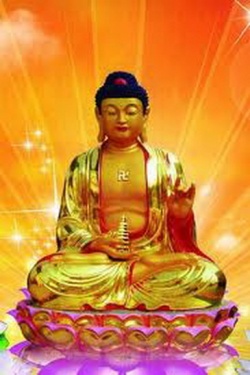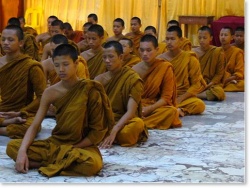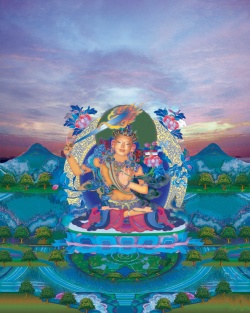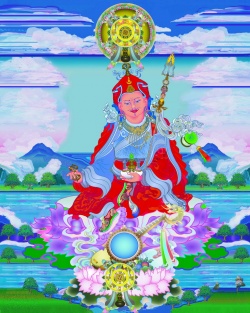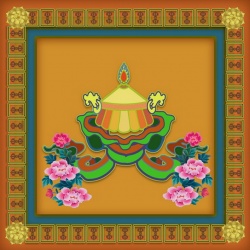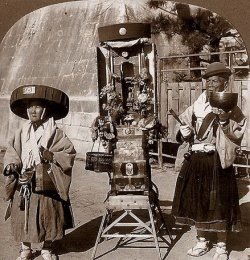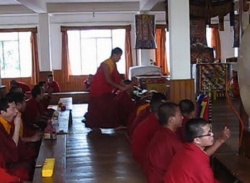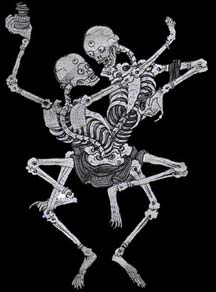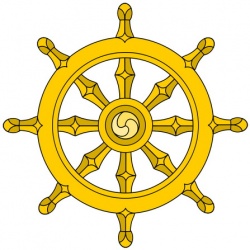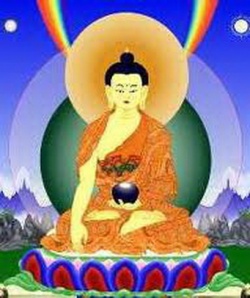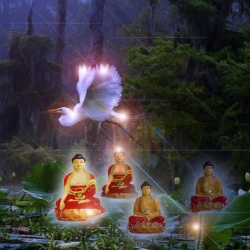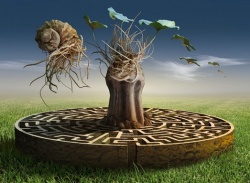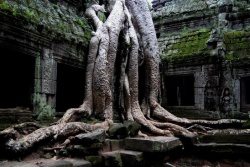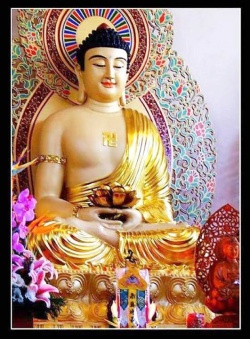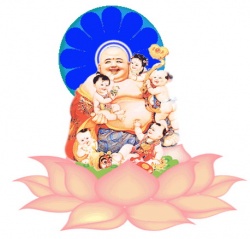Manual of Abhidharma - Additions Part 2
Class Six: Karma and Emptiness
How karma is caused through lack of understanding of emptiness:
Source: GYU LAMA (Sanskrit: Uttaratantra), which was dictated to Asanga by JAMPA
(a.k.a. Maitreya).This book describes six causal steps to creating karma:
1.) It starts with a bakchak from a previous life, where through ignorance, you saw a thing that appeared to be self-existent.
2.) Two kinds of ignorance spring up in your mind as a result:
a.) Tendency to grasp to a person’s self-existent nature (me, in general).
b.) Tendency to grasp to a self-nature of dharmas, or things (i.e. my bodily parts: my nose, my ears, my foot, etc.)
These are the two kinds of ignorance that exist in the world and cause all
3.) You look at pleasant and unpleasant objects and perceive them in a totally
incorrect way (as self-existent). You think they’re just happening on their own, but it’s your own projections on a blank screen.
4.) Based upon the above misunderstanding of the inherent pleasure or pain of the object, we have attachment or aversion for the object.
5.) You collect karma based upon thinking of the object with attachment or aversion, or acting out of attachment or aversion.
6.) You circle around in the cycle of suffering life. It perpetuates itself.
Water Analysis: (CHU – BAB)
Take a glass of water. A Buddha, a human, and a craving spirit see it as nectar, water, and pus respectively. Are each of them having a valid perception (pramana)? Yes, but you can’t have contradictory pramanas, so what’s going on? It’s empty, so each being’s perception is a valid pramana.
There is a material cause present, the stuff which turned into water (in this case water is the original stuff). There are contributing factors present, in this case each being’s karma, which leads them to see it as they do. There are three parts to the liquid (pus, water, and nectar) when the three beings are there looking at it. If only one being is there looking at
the water, the material cause and contributing factors make it only one thing. It must be this way since one object (the liquid) can’t be three different things at the same time (pus, nectar, and water). The three beings are each seeing a different part of the liquid simultaneously.
So however many types of beings are looking at the water, their contributing factors (karma) make the water have that many parts. If only a human is present, there will only be water in the cup. If a human and a Buddha are present, then there will be part nectar and part water in the cup, because two different karmas impact the cup of liquid.
Bakjaks increase and expand because we fertilize and nourish them with supporting thoughts and actions. When we stop fertilizing them, they won’t ripen.
Self-existence means that things exist independent of my conceiving them that way.
Class Seven: Karmic Path, Black and White Karma
The Desire Realm consists of hells, ghosts (aka craving spirits) animals, humans, demigods, and pleasure beings. Pleasure beings exist in form and formless realms, also.
Beings of the two higher realms (form and formless) don’t and can’t commit bad deeds, mainly because they are in deep meditation. They don’t perform new good deeds at this level, and they have bad deeds from before, so when the good karma from their previous good deeds is used up, they take rebirth in the lower realms.
Black and white karma:
NAKPOY LE Called black karma because its essence is black and its result is black. black karma Essence means it has to do with mental afflictions – it’s causing suffering or it is suffering. The result is black because the result is suffering. Black karma is collected in the desire realm, and is nonvirtuous.
KARPOY LE White karma refers to virtuous karma of the form realm – not desire white karma realm. The result is white – pleasure. The essence is white because the person doing the karma isn’t suffering outright (no suffering body, but must still age and die.)
KAR NAK DREPA Refers to virtue in the desire realm. The result is white-pleasure.
white black mixed The essence is black – mind and body are suffering as we do the karma. We can only do mixed black and white karma (or black only) in the desire realm.
Black and white karma refer to both the result of the deed and the nature of the being doing the deed. It doesn’t refer to good and bad deeds.
SAK-ME KYI LE Karma which doesn’t have a white or black result, but which unstained karma functions to remove the black karma. Ex. direct perception of selflessness: a pure virtue without a karmic ripening.
Two ways to remove desire for this life:
1.) JIKTEN PAY LAM
In the worldly path, you get into deep states of meditation and move up from the desire realm through each level of the form realm and formless realm. Your mind moves through the four levels of each realm. Your mind and meditation become progressively more subtle. Based upon whatever realm you meditate on the most, you will take rebirth there. (Meditation becomes the causal form realm and rebirth is the resultant form realm.)
When your mind reaches the first level of the form realm, you have no desire for sense objects because all senses are withdrawn in this realm. If you get used to pleasure of the first level of the form realm, all earthly pleasures pale. While on the first level of the form realm, you get a taste of the pleasures on the second level, and move up to that higher pleasure, so the first is no longer appealing. You keep doing that – pursuing higher pleasures and giving up lower pleasures. This isn’t a permanent giving up of desires. When you stop meditating, the mind comes back down to where you started.
The pleasure doesn’t stay, and it doesn’t lead to liberation.
It’s easy to mistake the higher pleasures for liberation, but they’re not. Only one state of mind can remove your bad thoughts and lead to liberation – understanding your selflessness.
2.) JIKTEN LE DEPAY LAM
world beyond path The path which is beyond the world.
This path transcends the world. You don’t give up the desire realm or the form realm because you’re moving up into higher levels of meditation; you give it up because you understand its selflessness – its emptiness. You remove your desire for an object because you understand its emptiness. When you reach the first level of the form realm in meditation, then you can see emptiness directly.
If you don’t focus your attention on emptiness while there, then you will keep doing more pleasurable meditation on higher realms. Once you have sufficient concentrative ability, you must shift your focus to emptiness, alternating your meditation between analytical and single-pointed concentration. Only seeing emptiness can remove your desire for higher pleasure realms as a motivation to meditate and practice.
Prayer works because the virtue of asking for something beneficial creates the cause to receive it.
There are four parts to a path of action, or karmic path (ex. killing):
1.) SHI
basis The object involved (ex. the person you killed)
2.) SAMPA The thinking involved, your intention or motivation (did you kill with premeditated anger or accidentally while trying to help someone).
Kinds of sampa:
a.) DU-SHE - correct identification. Is the person you kill the one intended?
b.) NYON-MONG - bad thoughts. Were you under the control of attraction, dislike, or ignorance when you committed the deed?
c.) KUN-LONG - motivation or intention. Did you want to kill or was it an accident?
3.) JORWA - undertaking the deed. Taking the weapon and going after the person.
4.) TARTUK – completing the deed. You collect the karma when the person actually dies.
LE LE KYI LAM
A path of karma (or action) motivates the mind to shift to its object. For example, illwill, craving, and wrong view are a path of karma. They motivate the mind to move, which is karma. The seven non-virtues of speech and body are karmas.
Karma is a movement of the mind. The mental functions which follow the mind, such as anger, love, etc., are not karma. (There is a big debate about this.)
Class Eight: Cutting Roots of Virtue; Projecting Karma
GE – TSA CHU-PA Destroying your root of virtue (collection of merit).
SUNAM GYI TSOK Collection of merit includes the first four perfections: giving, merit of collection not getting angry, morality, and effort. It consists of all the good deeds you have done.
YESHE GYI TSOK Collection of wisdom includes the fifth and sixth perfections wisdom of collection (wisdom and the concentration to be able to see emptiness).
You keep piling up good deeds (merit) and knowledge (wisdom). Your collection of merit causes a Form body (rupakaya), and your collection of wisdom causes a wisdom body (dharmakaya) of a Buddha. The wisdom body has two parts: the mind (or knowledge) and the emptiness of a Buddha. When you destroy your root of virtue, you wipe out and obliterate your collection of merit.
Two things that can cut your root of virtue:
(from Abhidharma):
LOK – TA Thinking the complete opposite of how something
diametric opposite view really exists. Looking at something that exists and thinking it doesn’t exist. For example thinking that karma doesn’t exist. It must be a total rejection of the idea to cut the root of virtue. Skepticism and doubt aren’t enough to be lok-ta.
(from Madhyamika):
KONG-TRO Anger directed at a bodhisattva. Each instant directed at anger him results in a kalpa in hell. The object is so powerful that identification, motivation, etc. are not important.
When you cut your root of virtue, Abhidharma says the virtues are wiped out and gone. Madhyamika says that it damages those good seeds so severely that they are inhibited from ever ripening and bringing a result. That’s how purification works – it damages negative seeds so severely that they won’t ripen.
Profile of who can collect a wrong view:
To have a wrong view, you must be able to hold a clear thought, or you can’t think about it to reject it clearly. You must evaluate it thoroughly enough to be able to hold a sustain thought in a firm way. Only humans can do this. Of humans, only those who are intellectual are capable of thorough evaluation and holding a firm, sustained rejection in mind.
Ways to repair a wrong view: (implies that you can restore previously damaged virtuous seeds to full potential)
1.) TE-TSM Having doubt that your previous wrong view is correct; doubting doubt your wrong view. You think, for example, maybe karma is correct.
2.) NGE-PA Having certainty that your wrong view is wrong and the to positively identify, correct view is correct. (Having a correct perception about it.) with certainty
Divisions of karma:
PENJE KYI LE Projecting karma. It throws you to your next rebirth. The projecting to do karma most powerful, strong karma throughout your life is the one likely to come up and project you to your next rebirth. It projects you to the bardo, and determines your bardo body and next rebirth. Because it’s the most powerful karma in your life, it projects your next rebirth.
DZOK JE KYI LE Completing or finishing karma. It decides the details of complete to do karma the next life. Projecting karma determines the overall type of life, and finishing karma determines all the many details of the life- rich, poor, accidents, etc.
Four permutations of projecting and finishing karma:
Example:
1.) Good projecting/bad finishing: Human rebirth/always sick
2.) Bad projecting/ good finishing: Hell rebirth/Lord of Hell
3.) Good projecting/good finishing: Human rebirth/become enlightened
4.) Bad projecting/bad finishing: Hell rebirth/endless torment
It’s very unlikely to be able to realize emptiness at the moment of death – almost
impossible. It’s the most painful moment of this life. Much better to do it in this life. Once you realize a certain level of the second path (preparation) in which you think about emptiness and have a strong intellectual understanding, it’s no longer possible to cut your root of virtue. You can’t doubt karma, emptiness, etc. If you’re engaged in activity with a group of people for the same common goal (war, for example) and someone else other than you – the soldier at the front line – kills, all the people involved possess a full karmic path of action just as much as the one who killed, even if you’re just working in the office behind the lines of fighting. The same line of reasoning applies to virtue.
Class Nine: Five Heinous Deeds
TSAM ME NGA Five heinous bad deeds: (These cause you to go to hell in the interim none five next life – no other choice)
1.) MA SUPA Killing your mother
mother kill
2.) PA SUPA Killing your father
father kill
3.) DRACHOMPA SUPA Killing an arhant
enemy destroyer (arhant) kill
4.) GENDUN GYI YEN JEPA Creating a schism; diving the sangha. If you do this one, sangha divide to do you must go to the lowest hell. (Sangha here means those in robes following Shakyamuni Buddha; you can’t commit this one now.)
5.) DESHEK LA NGEN SEM GYI TRAK JINPA To try to kill a Buddha with
Buddha from evil intention with blood to draw evil intention.
Two things that make these five actions so bad:
1.) PENPAY SHI Mother and father have helped you significantly by giving you a help basis life as a human capable of enlightenment. That’s why it’s so bad to kill them. It’s like you (1) reject your own Buddhahood (you are seeing your karma projected onto blank parents and want to kill it), and (2) want to eliminate it. Their raising you isn’t mentioned in sutras as significant; their giving you a body is what is important.
2.) YUNTEN GYI SHI The Buddha, Sangha, and Arhants are extraordinary extraordinary of object objects. You also reject them (the concept of a unified qualities Sangha, or the Arhant or Buddha) and want to eliminate them. The mental rejection of what these things stand for is what gives the deed its power in these cases. The unity of the sangha is the Dharmakaya, or an expression of the Dharmakaya.
Order of severity (starting with the worst) of these five deeds:
1.) Causing a schism – attacking the Dharma body. Results in one eon in the lowest hell.
2.) Trying to kill a Buddha – attacking the Form body.
4.) Killing your mother.
5.) Killing your father.
Profile of one who can create a schism: Must be a fully-ordained monk, charismatic, with good morality, very intelligent. The monk lies intentionally to the sangha, teaching five inaccurate rules to get to nirvana twelve years after the Buddha begins teaching, and not at Buddha’s death. The two main disciples must be present, and one repairs the schism within 24 hours.
Mental bad deeds are worse than verbal or physical bad deeds.
Par-kalpa: The first people on the planet live 80,000 years. They have wonderful lives, similar to the garden of Eden. They start to do non-virtue, and life spans decrease, eventually reaching only ten year life spans. The end result of this non-virtue is near destruction of the planet. Then they meet and decide to live virtuous lives, and the life span increases back up to 80,000 years. That’s one par-kalpa. There are sixty of those cycles in a great eon. A great eon contains the formation of the world, which takes a kalpa. A kalpa takes trillions of years. (Kalpa and great eon are the same thing?) Great eon contains the destruction of the world. Par-kalpas follow the same pattern in all worlds.
Class Ten: How to Make Karma More Powerful
JINPA Four kinds of giving:
giving
1.) DAK KI DUN CHIR Giving for your own benefit. Giving to inanimate objects, me of for benefit temple, etc. No recipient benefits. It is of benefit only to get results in the desire realm (samsara). Two types of people do this: those who aren’t free from desire for the desire realm or those in deep meditation free of the desire realm.
2.) SHEN DUN CHIR Giving for the benefit of others. No benefit to the giver; other for benefit doing it only to help others and not themselves. Aryas do this, when those who have seen selflessness give to ordinary people. Don’t wish for a result in the desire realm.
3.) NYI KAY DUN CHIR Benefit both self and other by giving. Giver wants result of both for benefit desire realm and recipient receives desire realm giving.
4.) NYIKAY MIN CHIR Neither benefit by giving. A Buddha giving to another both no benefit Buddha to honor them.
How to understand the most powerful giving; giving to bring the best karmic results:
Seven qualities of the giver that make the karmic result more powerful:
PAKPAY NOR DUN Seven riches of the Aryas. The best way to be when Arya (who has riches seven giving, to increase the power of the deed. Having these seen emptiness) qualities when giving vastly increases the karmic power.
1.) DEPA Concentrate on good qualities and want to become like that yourself.
Understanding the good qualities of holy beings, or goodness in general, and understanding those good qualities, admiring them, feeling joy and happiness about them being there, and wishing to be like them.
2.) TSUL-TRIM Avoiding the ten bad deeds. If you have morality when giving, the morality karma of giving is more powerful.
3.) TONG WA Don’t be stingy – be generous. Don’t give from the leftovers, give from giving the main pool of resources.
4.) TU-PA Classroom hours of learning, so that you know and understand what learning you are doing. If you give without awareness of what you’re doing, it has little benefit. You must understand the mechanics of what’s going on with the giving – the selflessness of the giver, the giving, and the gift, as well as how karma works, etc.
5.) NGOTSA SHEPA Don’t do bad deeds for reasons relating to yourself. No one be embarrassed to know would know if you did a bad deed, but you don’t do it for lose face your own conscience’s sake. If you have this quality in your personality when giving, it makes the karma more powerful.
6.) TREL YUP Don’t do bad deeds for reasons relating to what others will think
7,) SHERAB Understanding selflessness.
Qualities of the giving that make the deed most powerful karmically: The act of giving – the way in which you give – can increase the karmic power of giving. Three factors:
1.) Do it out of respect and have an attitude of respect in body language, presentation, manner, etc.
2.) Give what is really needed at the time it’s needed most.
3.) What you give can’t cause harm or be used for harm to the recipient.
The object of giving, to have the most powerful karmic result:
1.) DROWA Humans are better to give to than animals. It’s better to give to the type of being worst human, the worst criminal, than the best animal, because humans have the potential to reach nirvana in this life and animals don’t.
2.) DUK NGEL Giving to someone who is suffering is much more powerful than suffering giving to someone who is not in great need.
3.) PENPA Giving to a special object, such as someone like your parents who assistance have helped you. This is because they have given you a human body which can reach enlightenment.
4.) YONTEN Giving to those of high spiritual qualities, such as those coming out good qualities of high meditation for the first time. This is giving to honor the person. What is given is of no value to the person, but honors them. Holy beings don’t need the flowers, money, food, etc.
JE LA SAKPO Karma is committed and collected. It can also be committed and collected committed and not collected, according to Abhidharma.
Six things that cause karma to be committed and collected: (Collected means that a bakchak is planted in your mental stream.)
1.) Intentional - You mean to do it.
2.) Complete path of karma - All four parts are present: object, intention, undertaken, and completed.
3.) No regrets - You are glad you did it.
3.) No antidote - You didn’t do anything to make up for it. The most powerful antidote is to think of karma and the emptiness of the deed.
5.) Glad you did it.
6.) Definite karmic result - the result of the previous five. A karmic seed is definitely planted.
You can’t do everything – you have limited time and resources, so you want to make the most of what you do, to get the biggest result for your effort. The qualities of the giver (doer), the giving (deed), and the recipient makes the action most powerful. You can manipulate your karmic outcome by doing the deeds to bring the best karmic result. (The example here is for giving, but it also applies to the other perfections.) By having these qualities when you do a deed, the karma is massively more powerful.
Class Eleven: Course Review: Karmic Purification
TOP SHI – The four forces, used for karmic purification: (If all four parts are not complete, the purification does not work.)
1.) TEN GYI TOP Foundation force. The foundation is the one you offended – foundation force living beings or Buddhas. The deepest meaning is taking refuge – the mental state of refuge – ultimately understanding karma and emptiness. When you fall down, you stand up by reasserting your refuge. Your refuge is in your knowledge of karma and emptiness, not some blind belief. It’s understanding what’s happening.
2.) NAMPA R Destruction force. To rip out the roots of something (with SUNJINPAY TOP power). This is regret, not guilt. It is an intelligent, educated destruction force understanding that you just screwed up, based upon knowledge
of karma and emptiness and how bakchaks work and are reaped. You know that you will suffer from what you did and
why, karmically. You know you just caused yourself future suffering and regret it. You feel ill/bad.
3. NYE PA LE Restraint force. You don’t do it again. Since we can’t just stop LARNDOKPAY TOP cold for the rest of our lives, we need a plan. So we set a time restraint force limit to stop for awhile – not to do the deed for an hour, a day, a week, etc. and build up the time length to get used to the new habit of not doing the deed. For chronic habits, set a short time limit, say five minutes, and concentrate hard on not doing it. The mind can’t concentrate tightly for longer periods to avoid the habit. If you break a vow of restraint, you are lying, and collect more bad karma, so keep the time realistic.
4.) NYENPO KUNTU Antidote. You do something to make up for it. There are six
CHUPAY TOP possibilities:
antidote
1.) Recite holy names (like thirty-five Buddhas)
2.) Recite holy mantras (must be from a holy source and recited with good morality.)
3.) Study or read scriptures.
4.) Meditate on emptiness - most powerful because it conditions you to change for the next time. It’s the only thing that will lead to permanent change.
5.) Make offerings to holy objects. The highest offering is to succeed in your practice – to do what your lama taught.
6.) Use holy images.
Vajrasattva meditation is most powerful, because it incorporates this.
Karmic seeds expand, grow, and continue because we fertilize and nourish them with similar thoughts and deeds. If we stop fertilizing them this way, then they won’t ripen.
The karmic seeds you have are in a queue to ripen. The most powerful ones go to the front of the queue and are experienced first. They delay the other seeds from ripening until the powerful ones are done.
For every day you delay becoming a good person, you are affecting, influencing, and impacting others badly. Your problems are hurting other people and messing them up.
The longer you delay becoming enlightened, the more you hurt others.
The result of purification is that the intention part of the karmic path is ripped out and dramatically lessens the ripening impact. Karma ripens into a lesser result.
It’s very important after purification to believe that you’re clean – you’re pure. (That’s why last rites are important.)
See also
- Manual of Abhidharma - Reading One: Introduction to Abhidharma
- Manual of Abhidharma - Reading Two: The Nature of Karma, and What it Produces; the Detailist Concept of ''Non-Communicating Form''
- Manual of Abhidharma - Reading Three: Types of Deeds, and the Nature of Motivation
- Manual of Abhidharma - Reading Four: The Correlation of Deeds and Their Results
- Manual of Abhidharma - Reading Five: How Karma is Carried, According to the Mind- Only School
- Manual of Abhidharma - Reading Six: How Emptiness Allows Karma to Work, According to the Middle-Way School
- Manual of Abhidharma - Reading Seven: Black and White Deeds, the “Path of Action,” and the Root and Branch Non-Virtues
- Manual of Abhidharma - Reading Eight: Most Basic Virtue, and the Projecting and Finishing Energy of Deeds
- Manual of Abhidharma - Reading Nine: The Five Immediate Misdeeds, and the Concept of a Schism
- Manual of Abhidharma - Reading Ten: The Relative Severity of Deeds and What Causes It
- Manual of Abhidharma - Additions Part 1
- Manual of Abhidharma - Additions Part 2

